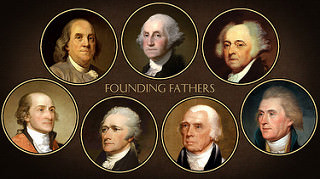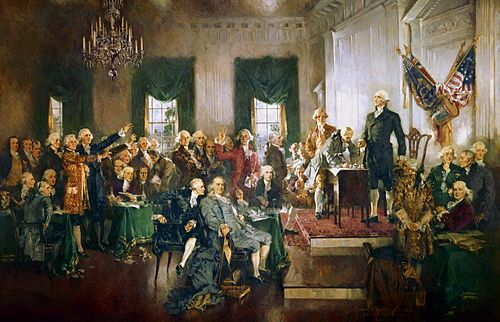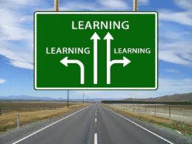1.4: The Founding Fathers
- Page ID
- 1995

The term Founding Fathers refers broadly to those individuals who led the American Revolution against the authority of the British Crown and established the United States of America. It may be more narrowly defined as referring specifically to those who either signed the Declaration of Independence in 1776. This term includes those who were delegates to the 1787 Constitutional Convention and took part in drafting the proposed Constitution of the United States.
Some historians define the "Founding Fathers" to mean a larger group, including not only the Signers and the Framers but also all those who, whether as politicians, jurists, statesmen, soldiers, diplomats, or ordinary citizens, took part in winning American independence and creating the United States of America.
In 1973, historian Richard B. Morris identified the following seven figures as the key Founding Fathers: John Adams, Benjamin Franklin, Alexander Hamilton, John Jay, Thomas Jefferson, James Madison, and George Washington. Three of these (Hamilton, Jay, and Madison) were authors of The Federalist Papers, a series of articles and essays advocating ratification of the Constitution.
Some lesser known, but no less important founders include James Wilson, Roger Sherman, and George Mason.
| FOUNDING FATHER | ESSENTIAL FACTS |
| John Adams |
John Adams was born in Massachusetts in 1735. He was a Harvard lawyer who defended the British soldiers after the Boston Massacre. He served as a delegate to both Continental Congresses and was on the committee to write the Declaration of Independence. He was the first Vice President and the second President of the United States. |
| Benjamin Franklin |
Benjamin Franklin was an inventor, writer, printer, diplomat, scientist, humorist, and statesman. He was born in Boston in 1706. In 1733 he started publishing Poor Richard’s Almanack. A distinguishing feature of Franklin’s almanac was his witty sayings and lively writing. During the French and Indian War, Franklin advocated colonial unity with his Albany Plan which encouraged the colonists to “Join or Die.” He was a delegate to both Continental Congresses and a member of the committee to write the Declaration of Independence. Franklin was the U.S. Ambassador to France and helped to negotiate the Treaty of Paris that ended the American Revolution. The French loved Franklin, and he was very popular there. Later, he was the oldest delegate to the Constitutional Convention at the age of 81. He became a member of the Pennsylvania Abolition Society before he died. |
| Alexander Hamilton |
Alexander Hamilton was born in the West Indies in 1755. He was the Aide-De-Camp (personal assistant) to George Washington during the American Revolution. He was a delegate from New York during the Constitutional Convention in 1787. As a proponent of a strong central government, he was one of the authors of The Federalist Papers (essays that promoted the ratification of the Constitution). Hamilton was the first Secretary of the Treasury under President George Washington. He worked to pay off the country’s war debts through his financial plan which included the assumption of state debts and creation of a national bank. He was the founder of the Federalist Party--considered the first political party. On July 11, 1804, he fought a duel with Aaron Burr who was angry over Hamilton’s support of Jefferson in the presidential election of 1800. Hamilton was shot by Burr and died the next day. |
| John Jay |
John Jay was born December 12th, 1745. Representing the point of view of the American merchants in protesting British restrictions on the commercial activities of the colonies, he was elected to the Continental Congress in 1774 and again in 1775. Jay did not favor independence from Britain. However, once the revolution was undertaken, Jay was an ardent supporter of the new nation. He drafted the first constitution of New York State and was appointed chief justice of the state in 1777. In the following year, he was again elected to the Continental Congress and was chosen as its president. The ineffectiveness of the Articles of Confederation led Jay to become a proponent of a strong national government and one of the primary authors of The Federalist Papers. After the Constitution was ratified, George Washington nominated John Jay as the chief justice, and he was confirmed two days later. Jay was instrumental in establishing the Supreme Court as a reasoned and honorable institution. He later retired from service in the Supreme Court and was elected (without even running) Governor of New York in 1795 where he proved to be a popular and productive governor. |
| Thomas Jefferson |
Thomas Jefferson was born in Virginia in 1743. As a Virginia planter, he was also a delegate to the House of Burgesses and to the First and Second Continental Congress. He was selected to draft the Declaration of Independence and is considered the author of the Declaration of Independence. Next, he was a U.S. Minister to France. Jefferson was the first Secretary of State under George Washington and Vice-President under John Adams. As Leader of the Democratic-Republican Party, in 1801 he became the third President of the United States. As President, he was responsible for the Louisiana Purchase in 1803 and the Embargo Act of 1807. In 1804, Jefferson sent the Lewis and Clark Expedition to explore the new territory purchased from France which produced a wealth of scientific and geographical knowledge. He died on July 4, 1826, the fiftieth anniversary of the Declaration of Independence. His self-written epitaph read: “Here was buried Thomas Jefferson Author of the Declaration of American Independence of the Statute of Virginia for religious freedom & Father of the University of Virginia.” |
| James Madison |
James Madison was born in Virginia in 1751. Madison was a delegate to the Philadelphia Constitutional Convention. He is widely considered the “Father of the Constitution” for his many contributions to the basic structure of our government. He used Montesquieu’s idea for separation of powers but also added a system of checks and balances to assure no one branch was too powerful. He authored the Virginia Plan, which proposed representation in the Legislative Branch based on population but was willing to compromise by creating a bicameral legislature. He supported ratification of the new U.S. Constitution and wrote over a third of The Federalist Papers, promoting its ratification. He helped frame the Bill of Rights. Then he became Secretary of State under Thomas Jefferson. He was the fourth President of the United States. During his presidency, the United States fought Great Britain in the War of 1812. |
| George Washington |
George Washington was born in Virginia in 1732. He was a Virginia planter and a delegate to the House of Burgesses. Washington fought during the French and Indian War and was a delegate to the Continental Congress. He was chosen Commander of the Continental Army during the American Revolution. Later, he became the President of the Philadelphia Constitutional Convention in 1787 and the First President of the United States. During his presidency, his foreign policy was to remain neutral. He warned the country against European entanglement and political parties in his Farewell Address. George Washington is referred to as the “Father of our Country.” |
The First Continental Congress
The First Continental Congress met briefly in Philadelphia, Pennsylvania in 1774. It consisted of 56 delegates from 12 of the Thirteen Colonies that later would become the United States of America.
The delegates were elected by their respective colonial assemblies and included George Washington (soon to be appointed commander of the army), Patrick Henry, and John Adams. Other notable delegates included Samuel Adams from Massachusetts, John Dickinson from Pennsylvania, and John Jay from New York.
A major influence at this meeting was James Wilson. In addition to signing the Declaration of Independence, Wilson was elected two times to the Continental Congress as a representative of Pennsylvania. Wilson was a member of the delegation, the Committee of Detail that wrote the first draft of the Constitution. James Wilson shared a similar philosophy to James Madison, and they allied to work for the Constitution's ratification. His input and campaign for the Constitution led Pennsylvania to be the second state to sign it. Due to his mastery of legal theory, he was one of the six original justices appointed by George Washington to the Supreme Court.
Roger Sherman, representative from Connecticut, was an early American statesman and lawyer, as well as a Founding Father of the United States. He is the only person to have signed all four state main documents of the United States: the Continental Association, the Declaration of Independence, the Articles of Confederation, and the Constitution. Along with James Wilson, he proposed the Three-Fifths Compromise, which counted slaves as three-fifths of a person for the purposes of representation in the United States House of Representatives.
George Mason was elected as a delegate to the Constitutional Convention from Virginia. He participated in the process of drafting the Constitution for months until he concluded that he did not fully support the Constitution because it did not contain a bill of rights. Mason also wanted to immediately end slavery. Although his ideas were not incorporated during this time, James Madison, a fellow Virginian and Founding Father, was intent to include a bill of rights during the First Congress in 1789.
This congress, in addition to formulating appeals to the British crown, established the Continental Association to administer boycott actions against Britain.
The Second Continental Congress
When the Second Continental Congress came together on May 10, 1775, it was, in effect, a reconvening of the First Congress. Many of the same 56 delegates who attended the first meeting participated in the second.
Notable new arrivals included Benjamin Franklin and Robert Morris of Pennsylvania, John Hancock of Massachusetts, and John Witherspoon of New Jersey. Hancock was elected president of the second Continental Congress two weeks into the session when Peyton Randolph was summoned back to Virginia to preside over the House of Burgesses.
Thomas Jefferson replaced Randolph in the Virginia congressional delegation. The second Congress adopted the Declaration of Independence. Witherspoon was the only active clergyman to sign the Declaration. He also signed the Articles of Confederation and attended the Constitutional Convention in New Jersey (1787) that ratified the Federal Constitution.
The newly founded country of the United States had to create a new government to replace the British Parliament. The Americans adopted the Articles of Confederation, a declaration that established a national government made up of a one-house legislature. Its ratification by all thirteen colonies gave the second Congress a new name: the Congress of the Confederation. They met from 1781 to 1789.
The Constitutional Convention
The Constitutional Convention took place from May 14 to September 17, 1787, in Philadelphia, Pennsylvania. It was held to address problems in governing the United States, which had been operating under the Articles of Confederation following independence from Great Britain.
Although the convention was intended to revise the Articles of Confederation, the intention from the outset of many of its proponents, chief among them James Madison and Alexander Hamilton, was to create a new government rather than fix the existing one. The delegates elected George Washington to preside over the convention. The result of the convention was the United States Constitution, placing the convention among the most significant events in the history of the United States.
The Framers of the Constitution
The men who attended the Constitutional Convention included some of the most prominent men of the revolutionary and post-revolutionary era. George Washington attended the convention, and he was chosen to be its president. Also in attendance were Benjamin Franklin, Alexander Hamilton, James Madison, and Roger Sherman. As a group, the Framers of the Constitution were wealthier and better educated than the average American. Nearly all of them had experience in state and national governments, and many of them had fought in the revolution. They were truly the “cream of the crop” of leaders and thinkers in America during the pre-colonial and post-colonial periods
The Missing Founders
While the Constitutional Convention included many luminaries, several famous figures from the Revolutionary Era did not attend. Patrick Henry and Samuel Adams, for example, were not there, and they both expressed serious reservations about the final document. Thomas Jefferson was also absent because he was serving as the American ambassador to France at the time.
Aims of the Framers
The framers aimed to create a stronger national government that would better protect and enhance liberty by preventing tyranny. The experience of Shays’ Rebellion and the states’ inability to cooperate with one another had also proven the weaknesses of the Articles of Confederation. Many Founding Fathers were concerned that Great Britain and other potential foreign powers would take advantage of those weaknesses, but the framers did not want to abolish the state governments.
This was a time in American history in which most Americans felt more loyalty toward their state government than to Congress or any other potential form of national government. A decentralized system with a strong local government made sense for the operation of a large nation such as the United States.

Scene at the Signing of the Constitution of the United States is a famous oil-on-canvas painting by Howard Chandler Christy. It depicts the Constitutional Convention signing the U.S. Constitution at Independence Hall in Philadelphia on September 17, 1787.

Study/Discussion Questions
For each of the following Founding Fathers, write a sentence which details and describes his contribution to the United States of America’s early government.
| John Adams |
Benjamin Franklin |
|
Alexander Hamilton |
John Jay |
|
Thomas Jefferson |
James Madison |
|
George Washington |
James Wilson |
|
Roger Sherman |
George Mason |
2. What occurred during the First Continental Congress? The Second?

